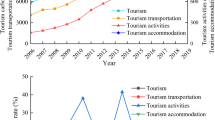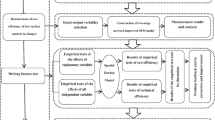Abstract
The global level of climate change agreement and the extensive development of China’s industrialization process have caused China to face severe pressures regarding energy conservation and emission reduction. Tourism industry plays an important role in promoting steady economic growth and improving ecological environment in China. The agglomeration economic effect it produces can reduce carbon emissions, but the crowding effect may not be conducive to low carbon development. Therefore, how to reduce carbon emissions while promoting the development of tourism industry has become an urgent problem. This paper measures the level of tourism industry agglomeration and carbon emission in 30 regions of China and uses the method of spatial econometrics to analyze the impact of tourism industry agglomeration on carbon emissions. The empirical results prove that tourism industry agglomeration can reduce the carbon emissions of local and neighboring regions in China. However, this does not mean that the larger the scale of tourism industry agglomeration, the more conducive to the reduction of carbon emissions. For developed tourism groups, the impact of agglomeration effect on carbon emissions of local and adjacent areas shows a U-shaped relationship. When the agglomeration level exceeds 1.963, the expansion of agglomeration scale will increase local carbon emissions. For underdeveloped tourism areas, there is an inverted U-shaped relationship between agglomeration level and carbon emissions both in local and adjacent areas. When the agglomeration level reaches 1.883, the expansion of agglomeration scale will reduce local carbon emissions. The conclusions provide a basis for Chinese government to guide the low-carbon development of the tourism industry from another perspective.


Similar content being viewed by others
Data availability
The datasets generated and/or analyzed during the current study are mainly from 2005 to 2016 “China Statistical Yearbook,” “China Tourism Statistical Yearbook,” “Tourism Sample Survey Data,” “China Traffic Yearbook,” and the “Statistical Bulletin of National Economic and Social Development.” The datasets supporting the results of this article are included within the article and its additional files.
References
Abdel-Rahman H, Fujita M (1990) Product variety, marshall an externalities, and city sizes. J Reg Sci 30:165–183. https://doi.org/10.1111/j.1467-9787.1990.tb00091.x
Akihiro O, Mika G, Toshiyuki S (2014) Energy efficiency and agglomeration economies: the case of Japanese manufacturing industries. Reg Sci Policy Pract 6:195–212. https://doi.org/10.1111/rsp3.12039
Andersson M, Loof H (2011) Agglomeration and productivity: evidence from firm level data. Ann Reg Sci 46:601–620. https://doi.org/10.1007/s00168-009-0352-1
Becken S, Patterson M (2006) Measuring national carbon dioxide emissions from tourism as a key step towards achieving sustainable tourism. J Sustain Tour 14:323–338. https://doi.org/10.2167/jost547.0
Becken S, Simmons DG (2002) Understanding energy consumption patterns of tourist attractions and activities in New Zealand. Tour Manag 23:343–354. https://doi.org/10.1016/s0261-5177(01)00091-7
Becken S, Simmons DG, Frampton C (2003) Energy use associated with different travel choices. Tour Manag 3:267–277. https://doi.org/10.1016/S0261-5177(02)00066-3
Brülhart M, Mathys NA (2008) Sectoral agglomeration economies in a panel of European regions. Reg Sci Urban Econ 38(4):348–362. https://doi.org/10.1016/j.regsciurbeco.2008.03.003
Chen LL, Thapa B, Yan W (2018) The relationship between tourism, carbon dioxide emissions, and economic growth in the Yangtze River Delta, China. Sustainability 10:1–20. https://doi.org/10.3390/su10072118
Dinda S (2004) Environmental Kuznets curve hypothesis: a survey. Ecol Econ 49:431–455. https://doi.org/10.1016/j.ecolecon.2004.02.011
Dwyer L, Peter F, Spurr R, Hoque S (2010) Estimating the carbon footprint of Australian tourism. J Sustain Tour 18:355–376. https://doi.org/10.1080/09669580903513061
Elhorst P, Zandberg E, De HJ (2013) The impact of interaction effects among neighbouring countries on financial liberalization and reform: a dynamic spatial panel data approach. Spat Econ Anal 8:293–313. https://doi.org/10.1080/17421772.2012.760136
Fagbohunka A (2012) The impacts of agglomeration on the immediate environment, using the Lagos regionas a study case. Eur Sci J 8:33–48. https://doi.org/10.5539/ibr.v5n12p143
Filimonau V, Dickinson J, Robbins D (2014) The carbon impact of short-haul tourism: a case study of UK travel to Southern France using life cycle analysis. J Clean Prod 64:628–638. https://doi.org/10.1016/j.jclepro.2013.07.052
GCP. Global carbon budget (2019) Earth System Science Data. retrieved from https://www.earth-system-science-data.net/about/news_and_press/2019-12-04_global-carbon-budget-2019.html. Accessed 4 December 2019.
Getis A (2009) Spatial weights matrices. Geogr Anal 41:404–410. https://doi.org/10.1111/j.1538-4632.2009.00768.x
Glaeser EL, Kallal HD, Scheinkman JA, Shleifer A (1992) Growth in cities. J Polit Econ 100:1126–1152. https://doi.org/10.1086/261856
Gössling S (2013) National emissions from tourism: an overlooked policy challenge? Energy Policy 59:433–442. https://doi.org/10.1016/j.enpol.2013.03.058
Gössling S, Daniel S, Hall M (2015) Inter-market variability in CO2 emission-intensities in tourism: Implications for destination marketing and carbon management. Tour Manag 46:203–212. https://doi.org/10.1016/j.tourman.2014.06.021
Gössling S, Peeters P, Ceron JP, Dubois G, Patterson T, Richardson RB (2005) The eco-efficiency of tourism. Ecol Econ 54:417–434. https://doi.org/10.1016/j.ecolecon.2004.10.006
Gossman G, Krueger A (1991) Environmental impacts of the North American free trade agreement. NBER Working Paper No.3914. :https://doi.org/10.3386/w3914
Han F, Xie R, Lu Y, Fang JY, Liu Y (2018) The effects of urban agglomeration economies on carbon emissions: evidence from Chinese cities. J Clean Prod 172:1096–1110. https://doi.org/10.1016/j.jclepro.2017.09.273
Hanandeh AE (2013) Quantifying the carbon footprint of religious tourism: the case of Hajj. J Clean Prod 52:53–60. https://doi.org/10.1016/j.jclepro.2013.03.009
Hao Y, Liao H, Wei YM (2015) Is China’s carbon reduction target allocation reasonable? An analysis based on carbon intensity convergence. Appl Energy 142:229–239. https://doi.org/10.1016/j.apenergy.2014.12.056
Hosoe M, Naito T (2006) Trans-boundary pollution transmission and regional agglomeration effects. Pap Reg Sci 85:99–120. https://doi.org/10.1111/j.1435-5957.2006.00062.x
Howitt O, Revol VGN, Smith IJ, Rodger CJ (2010) Carbon emissions from international cruise ship passengers’ travel to and from New Zealand. Energy Policy 38:2552–2560. https://doi.org/10.1016/j.enpol.2009.12.050
Huisingh D, Zhang Z, Moore JC, Qiao Q, Li Q (2015) Recent advances in carbon emissions reduction: policies, technologies, monitoring, assessment and modeling. J Clean Prod 103:1–12. https://doi.org/10.1016/j.jclepro.2015.04.098
Jackson J, Murphy P (2006) Clusters in regional tourism: an Australian case. Ann Tour Res 33:1018–1035. https://doi.org/10.1016/j.annals.2006.04.005
Jin L, Duan K, Shi C, Ju X (2017) The impact of technological progress in the energy sector on carbon emissions: an empirical analysis from China. Int J Environ Res Public Health 14:1505. https://doi.org/10.3390/ijerph14121505
Jones C (2012) Scenarios for greenhouse gas emissions reduction from tourism: an extended tourism satellite account approach in a regional setting. J Sustain Tour 21: 458-472. :https://doi.org/10.1080/09669582.2012.708039
Karathodorou N, Graham DJ, Noland RB (2010) Estimating the effect of urban density on fuel demand. Energy Econ 32:86–92. https://doi.org/10.1016/j.eneco.2009.05.005
Kelly J, Williams PW (2007) Modelling tourism destination energy consumption and greenhouse gas emissions: Whistler, British Columbia, Canada. J Sustain Tour 15:67–90. https://doi.org/10.2167/jost609.0
Konan DE, Chan HL (2010) Greenhouse gas emissions in Hawaii: household and visitor expenditure analysis. Energy Econ 32:210–219. https://doi.org/10.1016/j.eneco.2009.06.015
Kuo NW, Chen PH (2009) Quantifying energy use, carbon dioxide emission, and other environmental loads from island tourism based on a life cycle assessment approach. J Clean Prod 17:1324–1330. https://doi.org/10.1016/j.jclepro.2009.04.012
Lenzen M, Sun YY, Faturay F, Ting YP, Geschke A, Malik A (2018) The carbon footprint of global tourism. Nat Clim Chang 8:522–528. https://doi.org/10.1038/s41558-018-0141-x
Li M (2010) Decomposing the change of CO2 emissions in China: a distance function approach. Ecol Econ 70:77–85. https://doi.org/10.1016/j.ecolecon.2010.07.034
Li H, Chen JL, Li G, Goh C (2016) Tourism and regional income inequality: evidence from China. Ann Tour Res 58:81–99. https://doi.org/10.1016/j.annals.2016.02.001
Li XM, Shi PF, Han YZ, Deng AM, Liu D (2020) Measurement and spatial variation of green total factor productivity of the tourism industry in China. Int J Environ Res Public Health 17:1159. https://doi.org/10.3390/ijerph17041159
Li ZL, Sun L, Geng Y, Dong H, Ren JZ, Liu Z, Tian X, Yabar H, Higano Y (2017) Examining industrial structure changes and corresponding carbon emission reduction effect by combining input-output analysis and social network analysis: a comparison study of China and Japan. J Clean Prod 162:61–70. https://doi.org/10.1016/j.jclepro.2017.05.200
Lin TP (2010) Carbon dioxide emissions from transport in Taiwan’s national parks. Tour Manag 31:285–290. https://doi.org/10.1016/j.tourman.2009.03.009
Liu J, Cheng ZH, Zhang HM (2017a) Does industrial agglomeration promote the increase of energy efficiency in China? J Clean Prod 164:30–37. https://doi.org/10.1016/j.jclepro.2017.06.179
Liu J, Feng TT, Yang X (2011) The energy requirements and carbon dioxide emissions of tourism industry of Western China: a case of Chengdu city. Renew Sust Energ Rev 15:2887–2894. https://doi.org/10.1016/j.rser.2011.02.029
Liu J, Lin C, Huang L, Zhu JH, Wu LJ, Li YY (2017b) Use of household survey data as a tool to assess the carbon footprint of rural tourist accommodation and related services in China: a case study of Mount Qingcheng. Sustainability 9:1–17. https://doi.org/10.3390/su9101680
Lonngern K, Bai E (2008) On the global warming problem due to carbon dioxide. Energy Policy 36:1567–1568. https://doi.org/10.1016/j.enpol.2007.12.019
Majewska J (2015) Inter-regional agglomeration effects in tourism in Poland. Tour Geogr 17:408–436. https://doi.org/10.1080/14616688.2014.997279
Marshall A (1920) Principles of economics. Macmillan, London
Mattila JM, Thompson WR (1955). The measurement of the economic base of the metropolitan area. Land Econ 31: 215–228. :10.2307/3159415
Meng WQ, Xu LY, Hu BB, Zhou J, Wang ZL (2017) Quantifying direct and indirect carbon dioxide emissions of the Chinese tourism industry. J Clean Prod 163:401–409. https://doi.org/10.1016/j.jclepro.2016.03.067
O’Mahony T, Zhou P, Sweeney J (2012) The driving forces of change in energy-related CO2 emissions in Ireland: a multi-sectoral decompo\sition from 1990 to 2007. Energy Policy 44:256–267. https://doi.org/10.1016/j.enpol.2012.01.049
Patterson M, McDonald G (2004) How clean and green is New Zealand tourism? Lifecycle and future environmental impacts. Landcare research Science Series No. 24: Lincoln, Canterbury, New Zealand 2004. Available at: http://www.mwpress.co.nz/store/down loads/LCRSciSeries24_Tourism_4web.pdf. Accessed 20 September 2012
Peeters P, Szimba E, Duijnisveld M (2007) Major environmental impacts of European tourist transport. J Transp Geogr 15:83–93. https://doi.org/10.1016/j.jtrangeo.2006.12.007
Perch-Nielsen S, Sesartic A, Stucki M (2010) The greenhouse gas intensity of the tourism sector: The case of Switzerland. Environ Sci Pol 13:131–140. https://doi.org/10.1016/j.envsci.2009.12.002
Porter ME (1998) Clusters and the new economics of competition. Harv Bus Rev 6:77–91. https://doi.org/10.1201/b14647-11
Qiu XP, Fang YP, Yang XT, Zhu FB (2017) Tourism eco-efficiency measurement, characteristics, and its influence factors in China. Sustainability 9:1–19. https://doi.org/10.3390/su9091634
Robaina-Alves M, Moutinho V, Costa R (2016) Change in energy-related CO2 (carbon dioxide) emissions in Portuguese tourism: a decomposition analysis from 2000 to 2008. J Clean Prod 111:520–528. https://doi.org/10.1016/j.jclepro.2015.03.023
Shi PH, Wu P (2011) A rough estimation of energy consumption and CO2 emission in tourism sector of China. Acta Geograph Sin 66:235–243
Smith IJ, Rodger CJ (2009) Carbon emission offsets for aviation-generated emissions due to international travel to and from New Zealand. Energy Policy 37:3438–3447. https://doi.org/10.1016/j.enpol.2008.10.046
Sun YY (2016) Decomposition of tourism greenhouse gas emissions: revealing the dynamics between tourism economic growth, technological efficiency, and carbon emissions. Tour Manag 55:326–336. https://doi.org/10.1016/j.tourman.2016.02.014
Tabatchnaia-Tamirisa N, Loke MK, Leung PS, Tucker KA (1997) Energy and tourism in Hawaii. Ann Tour Res 24:390–401. https://doi.org/10.1016/S0160-7383(97)80008-4
Tang CC, Zhong LS, Ng P (2017) Factors that influence the tourism industry’s carbon emissions: a tourism area life cycle model perspective. Energy Policy 109:704–718. https://doi.org/10.1016/j.enpol.2017.07.050
Tian X, Chang M, Shi F, Tanikawa H (2014) How does industrial structure change impact carbon dioxide emissions? A comparative analysis focusing on nine provincial regions in China. Environ Sci Pol 37:243–254. https://doi.org/10.1016/j.envsci.2013.10.001
UNWTO-UNEP-WMO (2008) Climate change and tourism: responding to global challenges. UNWTO & UNEP, Paris & Madrid, pp 12–15. https://doi.org/10.1177/10634266040120030401
Vukina T, Beghin JC, Solakoglu EG (1999) Transition to markets and the environment: effects of the change in the composition of manufacturing output. Environ Dev Econ 4:582–598. https://doi.org/10.1017/S1355770X99000340
Wang B, Sun Y, Wang Z (2018) Agglomeration effect of CO2 emissions and emissions reduction effect of technology: a spatial econometric perspective based on China's province-level data. J Clean Prod 204:96–106. https://doi.org/10.1016/j.jclepro.2018.08.243
Wang K, Xiao Y, Li ZM, Liu HL (2016a) Spatial analysis for regional difference of tourism carbon emissions in China. China population, resources and environment 26:83–90
Wang SK (2013) Several types of weights matrix and their extended logic. J Quant Econ 30:57–63
Wang ZH, Zhang B, Liu TF (2016b) Empirical analysis on the factors influencing national and regional carbon intensity in China. Renew Sust Energ Rev 55:34–42. https://doi.org/10.1016/j.rser.2015.10.077
Wei YX, Sun GN, Ma LJ, Li J (2012) Estimating the carbon emissions and regional differences of tourism transport in China. Journal of Shaanxi Normal University 40:76–84
World Travel & Tourism Council (WTTC) (2020) Retrieved from https://wttc.org/Research/Economic-Impact
Yu B, Li X, Shi L, Qian Y (2015) Quantifying CO2 emission reduction from industrial symbiosis in integrated steel mills in China. J Clean Prod 103:801–810. https://doi.org/10.1016/j.jclepro.2014.08.015
Zhang YJ, Liu Z, Zhang H, Tan TD (2014) The impact of economic growth, industrial structure and urbanization on carbon emission intensity in China. Nat Hazards 73:579–595. https://doi.org/10.1007/s11069-014-1091-x
Zhao L, Dong YF (2017) Tourism agglomeration and urbanization: empirical evidence from China. Asia Pacific Journal of Tourism Research 22:512–523. https://doi.org/10.1080/10941665.2016.1277545
Zheng XY, Yu YH, Wang J, Deng HH (2014) Identifying the determinants and spatial nexus of provincial carbon intensity in China: a dynamic spatial panel approach. Reg Environ Chang 14:51–61. https://doi.org/10.1007/s10113-014-0611-2
Zhou XY, Zhang J, Li JP (2013) Industrial structural transformation and carbon dioxide emissions in China. Energy Policy 57:43–51. https://doi.org/10.1016/j.enpol.2012.07.017
Author information
Authors and Affiliations
Contributions
All authors contributed to the study conception and design. Material preparation, data collection, and analysis were performed by Jin-Wei Wang and Juan Dai. The first draft of the manuscript was written by Can Huang and all authors commented on previous versions of the manuscript. All authors read and approved the final manuscript. Conceptualization: Jin-Hua Cheng and Can Huang; methodology: Jin-Wei Wang, Can Huang, and Juan Dai; formal analysis and investigation: Chien-Ming Wang and Can Huang; writing—original draft preparation: Can Huang; writing—review and editing: Can Huang and Jin-Wei Wang; resources: Can Huang and Juan Dai; supervision: Jin-Hua Cheng.
Corresponding author
Ethics declarations
Ethics approval and consent to participate
Not applicable.
Consent for publication
Not applicable.
Competing interests
The authors declare no competing interests.
Additional information
Responsible Editor: Philippe Garrigues
Publisher’s note
Springer Nature remains neutral with regard to jurisdictional claims in published maps and institutional affiliations.
Rights and permissions
About this article
Cite this article
Huang, C., Wang, JW., Wang, CM. et al. Does tourism industry agglomeration reduce carbon emissions?. Environ Sci Pollut Res 28, 30278–30293 (2021). https://doi.org/10.1007/s11356-021-12706-2
Received:
Accepted:
Published:
Issue Date:
DOI: https://doi.org/10.1007/s11356-021-12706-2




